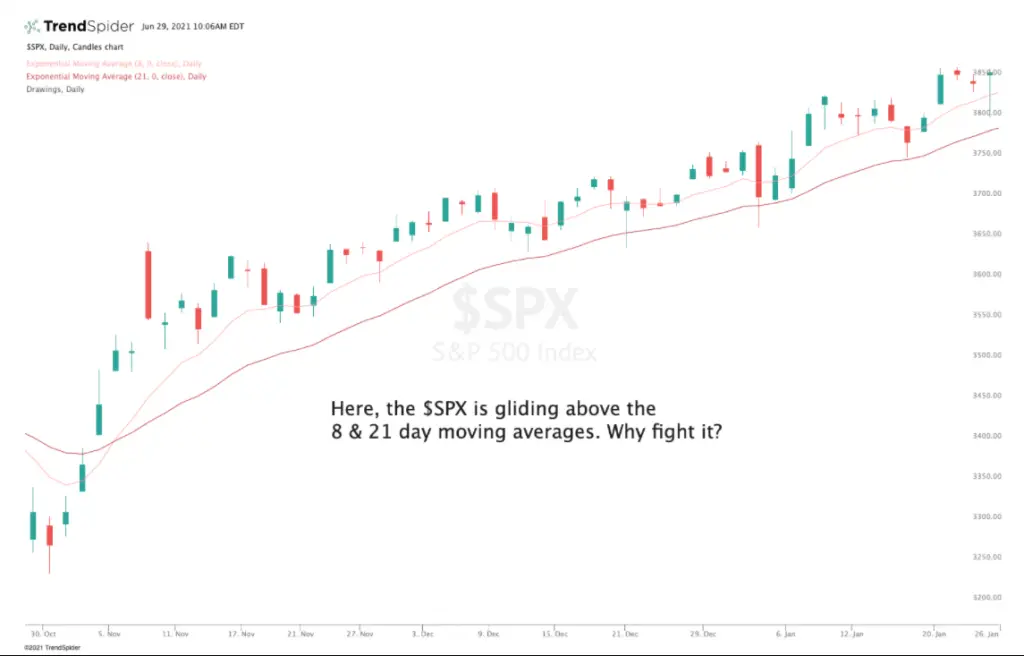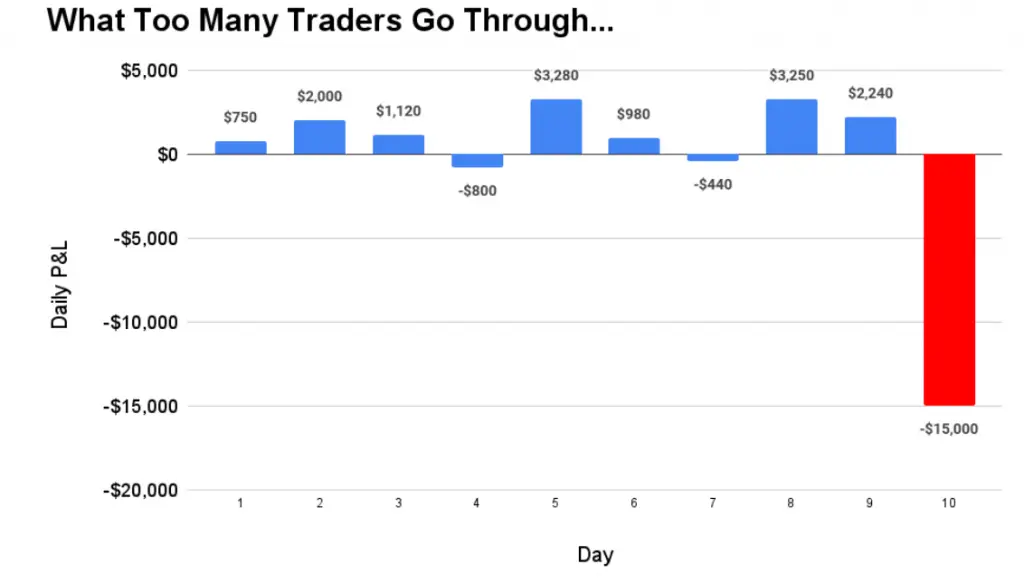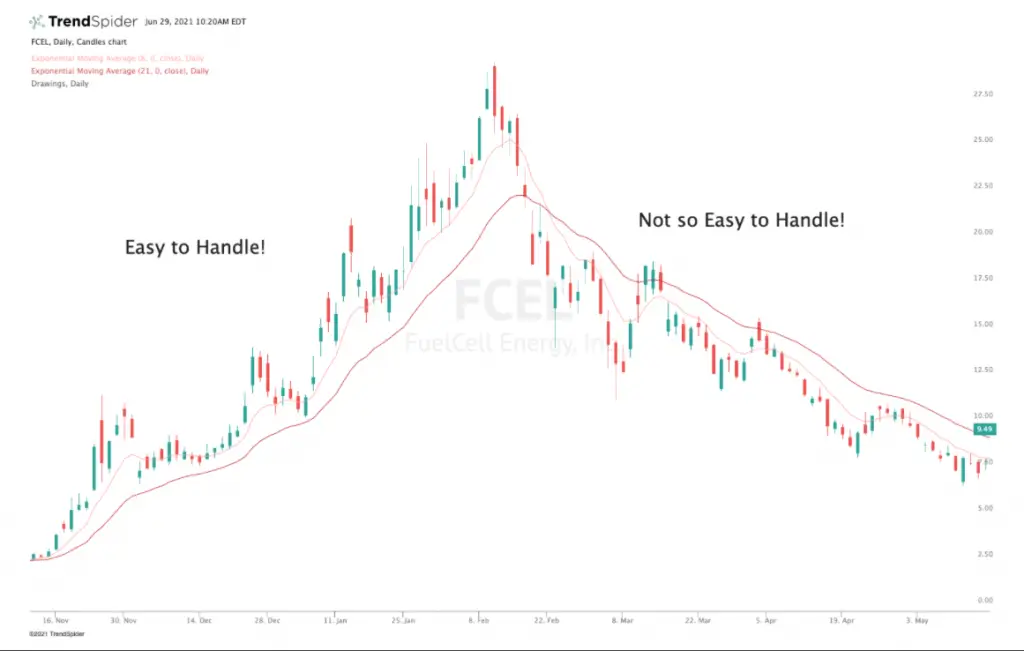This is a guest post by Scott Redler, Chief Strategic Officer of T3 Live and T3 Trading Group.
Scott has been a professional trader and technical analyst since 1999. His work has been cited by countless media outlets, including CNBC, Fox Business, Bloomberg, the Wall Street Journal, Reuters, MarketWatch, and Investor’s Business Daily.
***********
I’ve been a professional trader and technical analyst since 1999.
I’ve learned a lot of lessons along the way.
And, as you might expect, I didn’t learn them in school.
My real education happened on the trading floor, where I learned these 8 essential rules for success:
8. Keep Trading Simple
All of the best traders I’ve known have one thing in common: they keep it simple.
Remember what Bruce Lee said:
“I fear not the man who has practiced 10,000 kicks once, but I fear the man who has practiced one kick 10,000 times.
All you need is a few simple strategies and tactics plus the ability to manage risk (more on this later) and you can make a good living trading.
People are usually shocked at how small my toolkit is.
Most of the time, I’m looking at:
- The 8, 21, 50, and 200 day moving averages
- Trendlines, channels, and chart patterns
- Stocks and sectors showing relative strength
- One oscillator
- Level II screens
- My VTF® room where I share ideas with my subscribers
That’s all I need to make money.
And by focusing on fewer things rather than more, I have more energy for execution.
Speaking of focus, I recommend that all traders…
7. Focus on the Big Picture Trends
There’s a saying in trading: “The bearish argument always sounds better.”
But perfectly logical bearish arguments are wrong all the time.
Do you remember Brexit? President Trump’s election victory? The North Korean missile scare?
Plenty of people sold because of those events and then watched the market skyrocket.
Even the Covid-19 pandemic quickly turned into a massive buying opportunity.
That’s why I’m obsessed with the big picture trends. My main rule is pretty simple: when the SPX is trending above the 8 and 21 day moving averages, I want to be long multiple stocks showing relative strength. (at the end of this article, there’s a link to my moving averages eBook)

It’s easy to fall into the trap of wanting to be right about the economy and politics or whatever else.
But the price action is what pays us.
Are there things that worry me about the world? Yes.
Am I going to trade on those things? No.
If the SPX is powering hard above the 8 and 21 day, the bad news just doesn’t matter.
6. Learn to Lose Small
I like to say “we can handle paper cuts, but we can’t handle gushers.”
A lot of traders will actually be fairly consistent… and then they’ll find a way to give it all back. They’ll lose a month’s worth of profit in 15 minutes.
You might be surprised at how often a trader’s P&L looks like this.

Smooth sailing… and then a huge loss.
Let’s say you make $50,000 during a big market rally. If you lose $20,000 of that on a drawdown, you’re either taking too much risk or you’re not respecting sell signals.
I’ll think about selling a stock when it:
- Gets stretched way above the 7 day moving average
- Fails to hold above a prior high
- Goes red and shows relative weakness
- When it breaks a prior day’s low
Do I sometimes sell too early? Yep!
But I rarely have those big, nasty, soul crushing losses.
And when the market falls apart, I’m not giving back a month’s worth of P&L in one morning.
5. Treat Every Day Like a New Day
Did you make $10,000 yesterday?
Or did you lose $100,000?
Either way, put your joy (or grief) aside. Focus on what’s in front of you now.
You can’t trade your P&L.
Let me give you an example.
Say you just had the best trading day of your life. Let’s call it $50,000.
The WORST thing you can do is assume “I’ve made enough money this month, so I’ll hang back for a while.”
The reality is that you could be passing up opportunities that could give you a $75,000 or $100,000 day.
On the flip side, let’s say you lost $50,000.
You may want to revenge trade to make that money back. That is very dangerous because you’re acting out of emotion, which leads to disaster.
The past — whether it was good or bad — is gone, and you can’t change it.
So focus on what can make you money right now, regardless of what happened yesterday.
4. Develop a Daily Routine
Every morning, I wake up at 4:45 a.m. ET and I bid my community “good morning.”
Good morning
— Scott Redler (@RedDogT3) June 29, 2021
Why? Because I’m kicking off my routine.
Successful people don’t show up asking themselves “so what do I do now?”
Legends like Steve Jobs, Benjamin Franklin, and Kobe Bryant all used daily routines to stay productive and focused on their goals.
Traders should be no different.
So I’m challenging you to make a checklist of 10 things you’re going to do when you fire up your platform in the morning.
This can be stuff you’re already doing.
But I want you to systemize it so you flow from one task to the next without getting sidetracked by the news, social media, or TV.
It could be checking news, scanning charts, tracking futures, previewing the economic numbers, whatever.
Just have a routine and stick to it.
You’re not just managing your time. You’re managing your energy. And by removing distractions, you can focus your energy on what matters: executing.
3. Know What You Can Handle
Some of my subscribers want to copy all my trades.
But you might not be able to handle the same kinds of stocks I trade. And you might not be able to handle some of my strategies.
For example, I’ve gone home on Fridays short Tesla (TSLA) call options.
So I’d be at risk of losing hundreds of thousands of dollars if the stock opened up $100 or $200 on Monday.
Can you handle that? Maybe. And maybe not.
On the other hand, there are things I can’t handle.
Like I won’t take stock into earnings.
I also don’t trade futures, because I’m busy enough as it is.
Here’s where things get tricky: when you are making money, you can handle anything.
You only know what you can really handle when you LOSE money.
Look at this chart of Fuelcell Energy (FCEL).

When FCEL was going to the moon, anyone could handle it. Because when you’re making $500 or $1,000 every day, you don’t feel anxiety. You feel euphoria.
After the top? Not so much. How you deal with hard times shows you what you can handle.
So look back at the times when you’ve lost money.
You should have an idea of whether you’re taking the right amount of risk.
2. Don’t Live Your P&L
Earlier, we talked about not trading your P&L. Now let’s talk about not living your P&L.
If you just had your best year ever, I have some very bad news for you.
You are at risk of having your worst year ever.
Let me explain. Many traders have a big year (or even month) and start spending.
They buy a new car or house, they start flying first class to Vegas to play poker, and guess what? They’ve doubled or tripled their monthly nut.
And after a few bad days, they’re thinking “I need to make $15,000 by the end of the week because I’m behind on the mortgage and car payments.”
So forget about approaching the market in a calm, rational pattern.
Never live on a P&L that might not be sustainable.
I had a great 2020, but I didn’t buy a new house. Instead, I put in a new kitchen and sauna in my house — nice things that don’t give me higher monthly expenses.
Trading is hard enough. Don’t let your success turn into the pressure that drags you down.
1. Don’t Go It Alone
Too many traders view the markets as a zero sum game and they hole up in a corner, afraid to share anything.
But I’ve found that the more you give, the more you get.
And I’m not just talking about ideas and strategies.
I’m talking about a sense of community.
If most of your friends and family have traditional jobs, they’ll have a hard time relating to what you go through as a trader — both the ups and the downs.
Plus, in a team environment, you can get feedback on what you might be doing right or wrong.
Sometimes a fresh set of eyes can help you spot holes in your game and move you to the next level.
So don’t be a lone wolf. Get out there and be part of something. You can start with my #630club on Instagram!
Want to Learn My Trend Analysis Framework?
Then pick up The Ultimate Guide to Moving Averages — downloaded by over 12,500 traders so far!